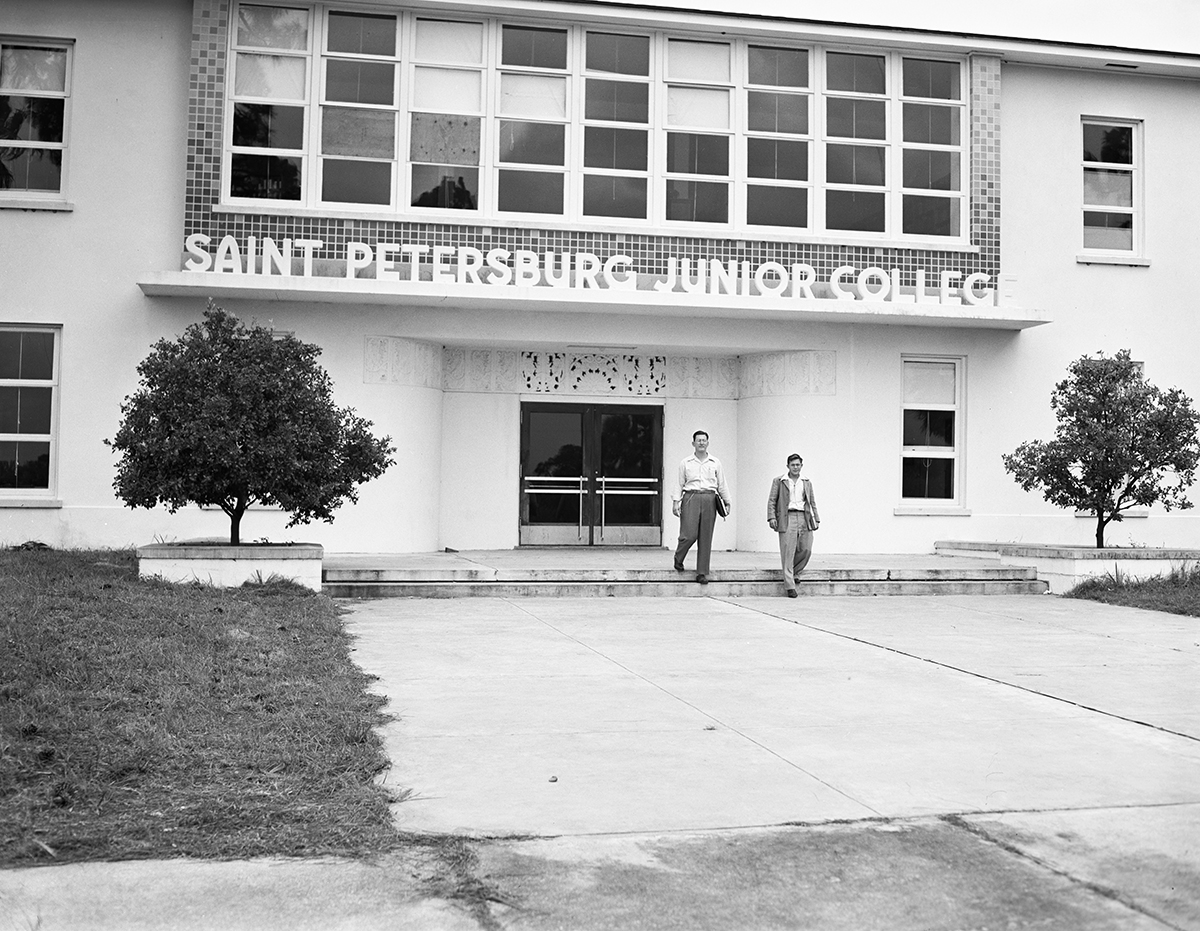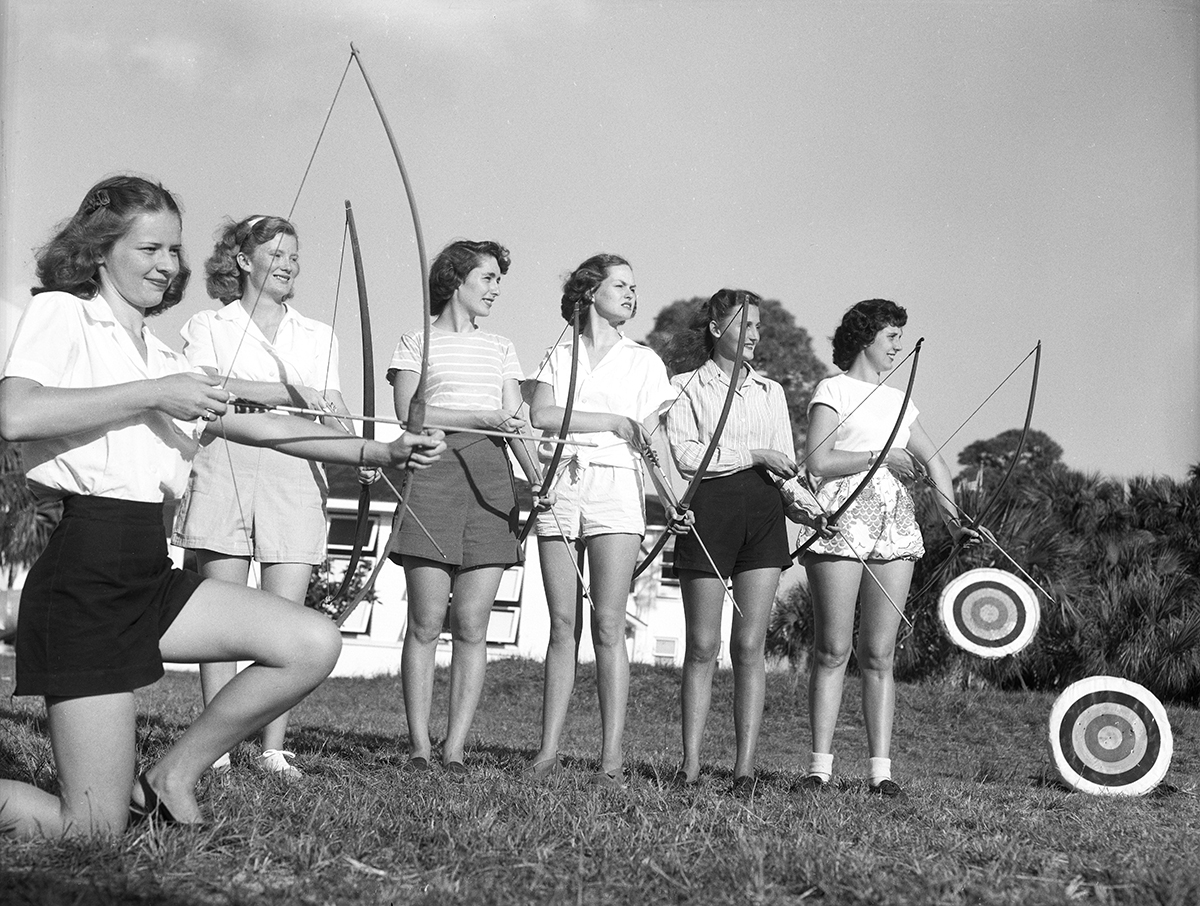In May 1929, St. Petersburg Junior College (SPJC) celebrated its first graduating class. About half of the 48 soon-to-be alumni earned their two-year arts and sciences diplomas, and the other half graduated from the teachers training program. No doubt, the inaugural group of graduates imagined bright futures for themselves. So did the college. Its first commencement program proudly notes: “The college, in its short period of activity, has increased rapidly in size and importance, giving promise of becoming a still more worthy and flourishing institution in the future.”
Junior College: A New Idea for Florida
On Sept. 13, 1927, the first class of 91 students launched their SPJC journey, despite the fact that they and the 14 faculty members teaching them were still waiting for textbooks and had to borrow rooms from the local high school. Enrollment soon grew to 102, but three months later, defenders were still having to explain the concept of a two-year school and sell it as an advantage, rather than a burden, to the community. In December 1927, the St. Petersburg Times extolled the cultural and economic boost SPJC provided both its students and the community at large, concluding: “Thus we believe the St. Petersburg Junior College has already justified the faith of the men and women who sponsored it.” Over the next 18 months, the school continued to prove itself worthy. By that 1929 commencement, graduates and staff had reason to be optimistic. SPJC had taken over the former St. Petersburg High School on Mirror Lake (presentday site of the judicial building), established its first scholarship endowment, doubled its enrollment, and was well on its way to full accreditation. The idea that St. Pete needed an institution of higher learning for aspiring white locals who couldn’t afford the tuition and boarding costs of an out-of-town school was clearly catching on.

The College Experience in Half the Time and a Fraction of the Cost
At $50 per year, the new two-year SPJC was considerably less expensive than a four-year institution, which could average anywhere from $150 to $250 or more per year, plus the expense of books and room and board. For local students in particular, these savings made college possible. Since teaching required only a two-year certificate at the time, the teachers training graduates, almost exclusively women, were ready to meet the growing demand for teachers linked to the expanding population and compulsory school-attendance laws. The arts and sciences graduates, mostly men, could either move on to a four-year institution or take their new skills into the job market. This lower cost to attend junior college did not mean students had to sacrifice curriculum or the collegiate experience. SPJC offered courses in everything from history, economics, and physics to art, science, and music. Plus, when students weren’t in class, they could participate in a variety of campus clubs organized to enhance their educational experiences or to widen their horizons. The very first club, Dramatic (soon renamed The Play-Makers), was followed quickly by a contemporary literature club (dubbed the Reviewers), and a men’s-only glee club, as well as science-math, poetry, and debating clubs. As with four-year institutions, newly fashionable and exclusionary social clubs, known only by their initials, also emerged. Competitive contests had become increasingly popular as well, and inaugural SPJC Trojans fans could cheer on football and basketball teams. In 1927, the basketball team gave the “Poinsettia Ice Cream five” their first loss in SPJC’s first game before they went on to consecutive successful seasons, and in 1929, SPJC fielded an undefeated football team. Students also anticipated the fun of the popular May Fete.

Changes
Even as the Great Depression and World War II offered challenges, SPJC continued to grow and adapt. After gaining full accreditation in 1931, it briefly offered three-year programs before Archery class at Saint Petersburg Junior College – Saint Petersburg, Florida. 1947-11-05. State Archives of Florida, Florida Memory. reverting back to its successful two-year model in 1938. That same year, officials began plans for expansion to accommodate the growing enrollment, which by 1941 stood at 317 students. The local community raised nearly $100,000 to help SPJC purchase 25 acres of empty land. With the help of federal Works Progress Administration funds, the school moved in 1942 to a new campus at Fifth Avenue N and 66th Street. With room to grow, SPJC transitioned from a private nonprofit to a fully public institution in 1948. Unfortunately those growth plans did not include Pinellas County’s Black population. SPJC’s refusal to integrate (even after the Brown vs. Board of Education decision mandating desegregation) contributed to the establishment of Gibbs Junior College (GJC). Opened in 1957 with 254 students, it quickly relocated from a borrowed space in Gibbs High School to its own facility. By 1964, it had grown to more than 900 students. Its success, however, had not stopped efforts to desegregate SPJC. In 1961, with the help of the Ambassador Club, Rosalie Peck and Frankie Howard became the first Black SPJC students. By 1967, GJC had been absorbed into the SPJC system and, continuing its expansion, SPJC had added another campus in Clearwater. Many changes were still ahead, but 40 years after the fledgling school’s first students sat in borrowed rooms, St. Petersburg Junior College, with its three campuses and more than 8,000 students, certainly had “justified the faith of the men and women who sponsored it.”
Full sources available on request.


